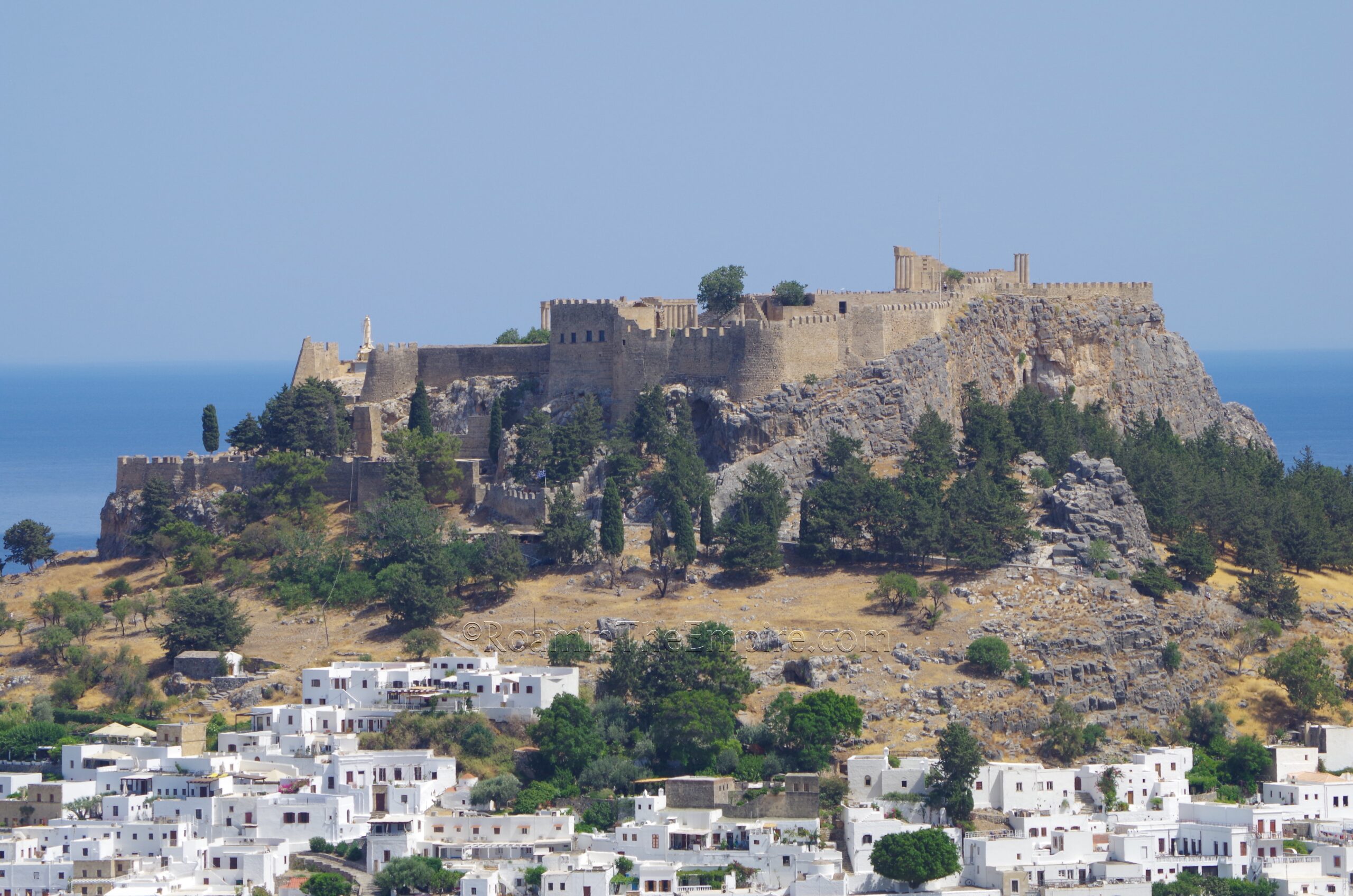
Most Recent Visit: July 2021
One of the three ancient city-cities of Rhodes, located on the southeastern coast of the island, Lindus (or Lindos) was, according to myth, founded by Tlepolemus in the 13th century BCE. The son of Heracles and Astoche, Tlepolemus fled to Rhodes after accidentally or intentionally killing his father’s friend, Licymneus. He divided the island up and along with Lindus, also founded Ialysus and Cameirus. The three Rhodian cities along with Cos, Cnidus, and Halicarnassus formed the Dorian Hexapolis, and later the Dorian Pentopolis after Halicarnassus was expelled. Lindus, along with the other two cities of Rhodes, was among the catalogue of ships in the Iliad, led by Tlepolemus, who later meets his death at the hands of Sarpedon.
Lindus became an important trade center from around the 8th century BCE, particularly with regard to Phoenician trade and was the most prominent and important of the Rhodian cities. The philosopher, poet, and statesman Cleoboulos was born there in the 6th century BCE, sometimes counted among the Seven Sages of Greece. He was an important figure for the city, being linked to building projects such as the construction of fortifications around the acropolis as well as the construction of a temple to Athena Lindia. Lindus is mentioned in passing in Thucydides’ history of the Peloponnesian War, but does not feature in the major action. Toward the end of that conflict, the city of Rhodes is founded in 408 BCE, which drew populations from the three original cities of the island, and formed a unified political entity that left Lindus somewhat declined in importance. The presence of sanctuaries of Athena Lindia and Heracles (which contained an image of the hero painted by Parrhasius) allow the city to retain some standing as a religious pilgrimage site.
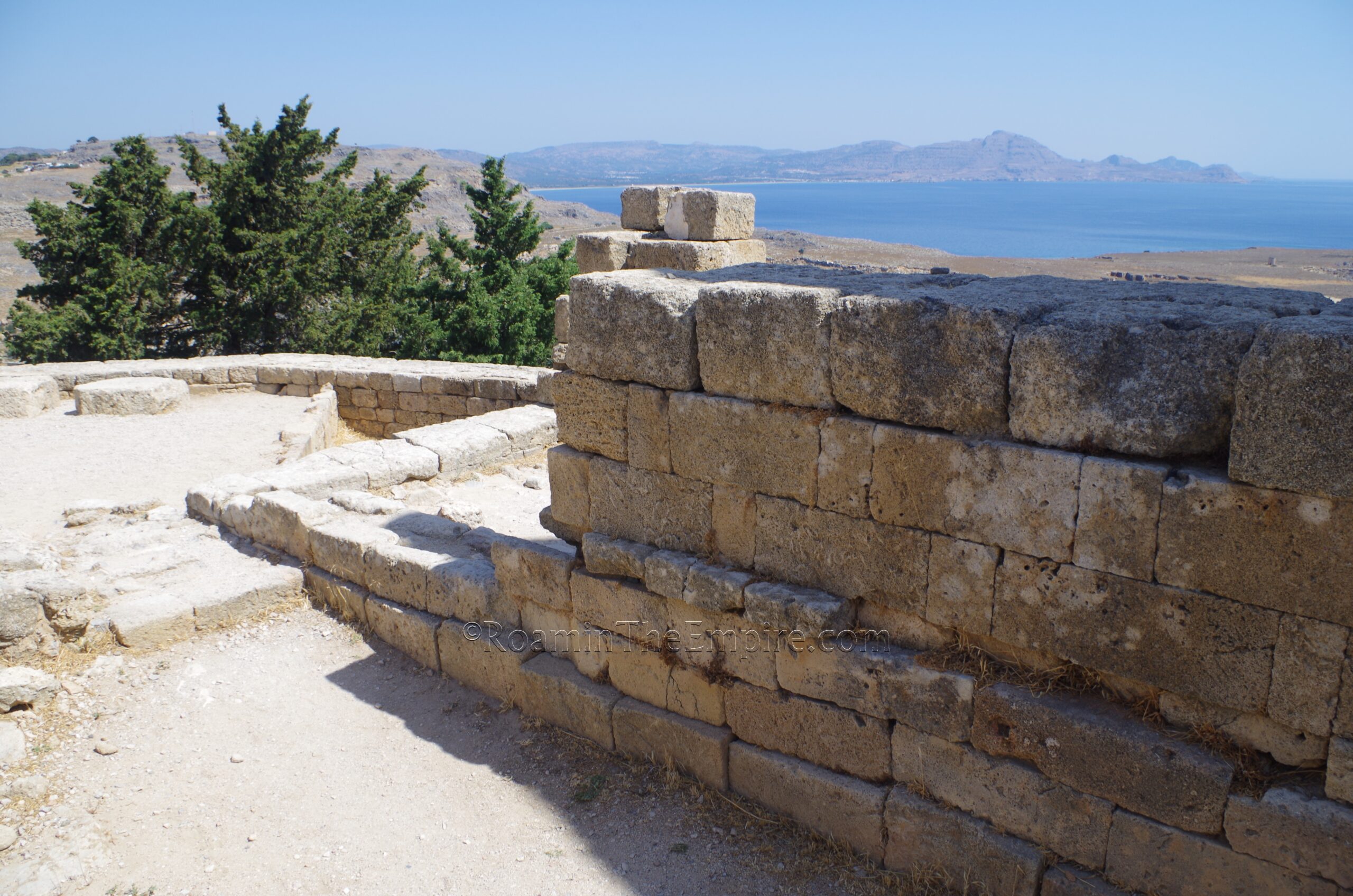
Lindus came under the hegemony of Rome in 164 BCE, when the island entered into an alliance with the Romans that allowed them to retain some nominal autonomy, though effectively granting Roman control. The Rhodian maritime law, developed at Lindus, would become the basis for Roman maritime law, though it is not completely clear when this happened. The city never again attained its earlier prominence, and doesn’t feature much in the historical record after the founding of the city of Rhodes, but remained a modest population center through antiquity and beyond. Constructions and dedications during the Roman period attest that it was still an important cult center, even if it wasn’t very significant beyond that.
Getting There: As Lindos is a fairly high profile tourist destination on the island, there are pretty frequent daily buses running between Rhodes City and Lindos, even on Sunday (during the summer, at least). The price is 5.50 Euro and a timetable can be found here. Personal vehicle is also a pretty good option; for this specifically, but also for the island in general. There seemed to be suitable parking around the outskirts of Lindos, particularly if you arrive early. It is about a 45 minute drive from the vicinity of Rhodes City.
The archaeological area of the Acropolis of Lindos is located, very vaguely, up the stairs from the town. There are signs here and there, but generally heading in a northeast direction up the hill will eventually get you there. The acropolis is open from 8:00 to 20:00 in the summer (April 1 to October 31) and from 8:00 to 15:00 the rest of the year. Admission is 12 Euros.
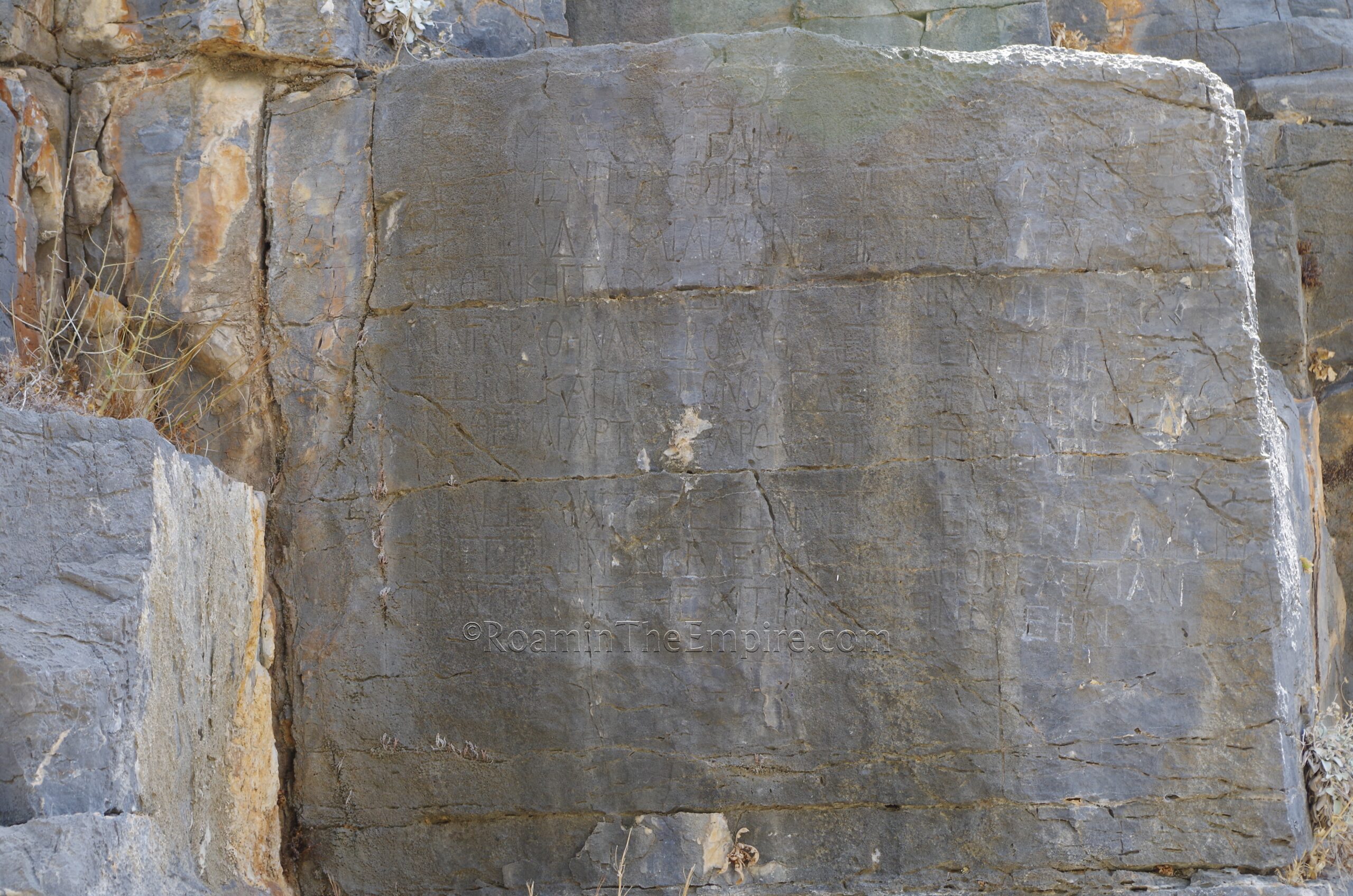
Before entering the actual pay area of the acropolis, about halfway between the last building of the town and the ticket kiosk for the acropolis, right about where the stairway/path takes a noticeable turn, there is a rocky outcropping to the east side of the trail (right side if you are headed up). There are a number of inscriptions dedicated to gods inscribed on these apparently naturally sheer rock faces. Most are fairly faded and require a bit of off-trail wandering to see up close. There is one particularly long and well preserved inscription near the trail, though. Unfortunately I haven’t been able to find a whole lot of information on these beside that.
Once past the ticketing area and actual entrance to the site is a small plaza where perhaps one of the most famous points of interest for Lindus resides, the relief of the Rhodian galley. Carved into the living rock of the acropolis is a high relief depicting of a Rhodian warship, likely a trihemiolia, a fast and powerful Rhodian ship developed in the 4th-3rd century BCE similar to a trireme. This relief was believed to have been created around 180 BCE to honor the admiral Agisandros Mikkion, of whom a bronze bust or statue would have adorned the prow of the ship. An inscription on the relief attributes the work to Pythokritos of Rhodes, a sculptor who is also believed to be responsible for the famous Nike of Samothrace (now in the Musée du Louvre in Paris), which interestingly also includes the depiction of a ship’s bow.
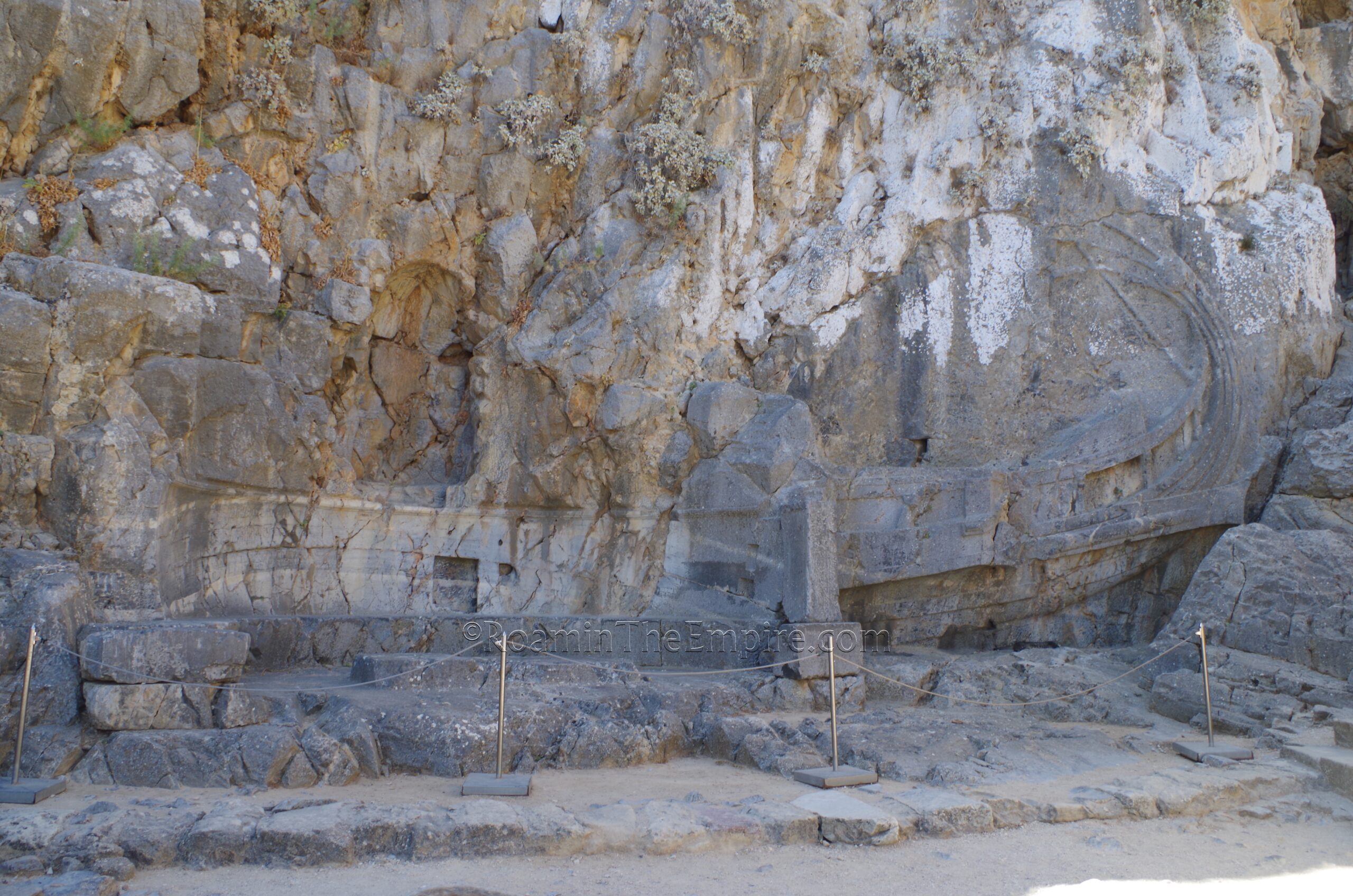
At the aft of the ship is an exedra cut into the rock. This feature was originally constructed in the 2nd century BCE, around the same time as the warship relief. In front of the exedra are the remains of a rock cut altar. Visible on the exedra is a metrical inscription honoring Aglochartos, who was one of the final priests of Athena Lindia, and who is noted as planting olive trees on the acropolis. This inscription is dated to the 3rd or 4th century CE. Both the relief and exedra and roped off and can’t be approached closely. A number of free standing inscriptions adorn the plaza around the rock-cut features, though unfortunately there doesn’t seem to be much information on these.
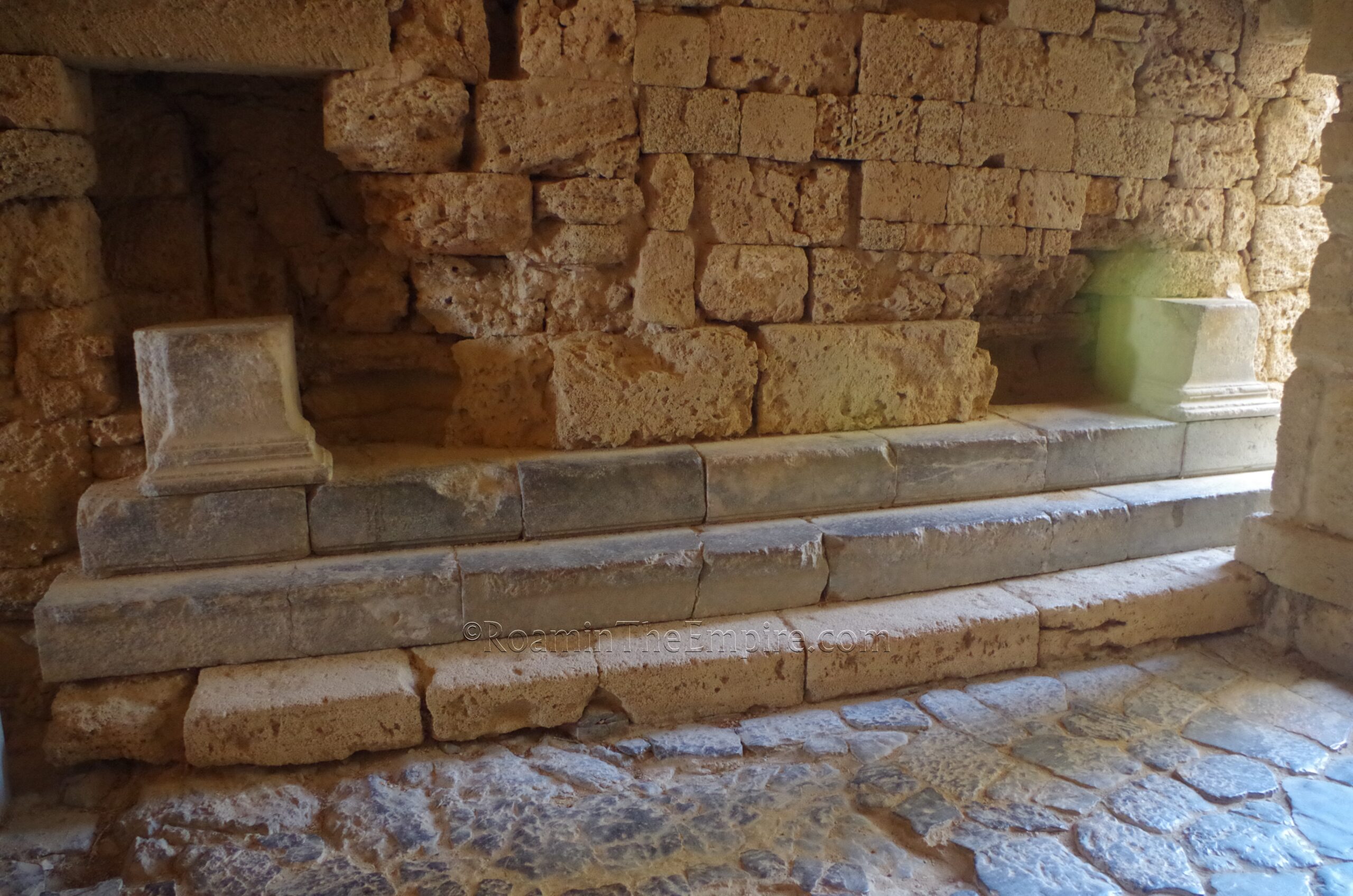
From there, a stairway continues up from the area of the relief and exedra into some medieval/Byzantine administrative structures. A number of ancient inscriptions are also housed here, but once again, there is little to no information regarding their context or content. This then leads out to a courtyard with access to the Byzantine Agios Ioannou church as well as some additional inscriptions to the west and a path that leads up to the acropolis. There is also an egress through another medieval/Byzantine administrative building to the east, which again houses a number of inscriptions as well as a couple other interesting objects. Nearest the western door are the remains of a naiskos in antis with three steps and the bases of two antae from a 2nd century BCE monument incorporated into the later walls of the structure. It was apparently only in use for about a century before an expansion of the vaults (visible outside) in the 1st century BCE rendered it unusable. Toward the center of the room are a few steps from an archaic period staircase hewn into the rock of the floor.
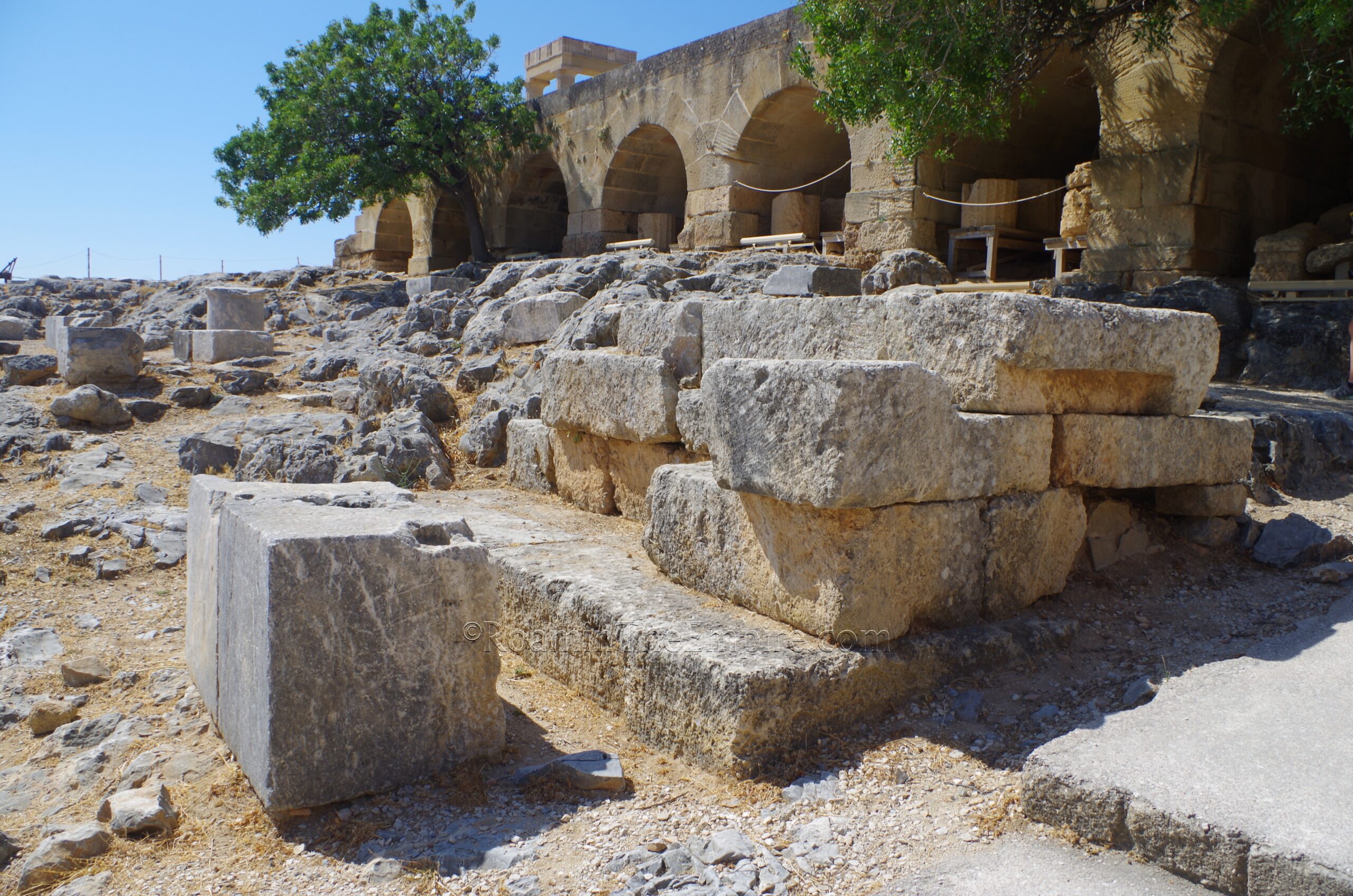
Exiting out the east side of this building leads to an area that is bounded on the south by a series of late 1st century BCE vaults that formed part of a lower terrace on which the primary buildings of the Hellenistic acropolis were constructed. These vaults stretch to the southeast for about 45 meters, with a break about 15 meters on for a staircase. Both the vaulted terrace wall and staircase replaced earlier iterations of similar structures. The vaulted chambers were used for storage. Immediately to the north is a large votive exedra dedicated originally to a priest of Athena Lindia and Zeus Polieus named Pamphilidas in 215 BCE. A bronze statue of Pamphilidas, created by the sculptor Phyles of Halikarnassos, was set atop the exedra. Over the next century or so, a number of other statues of family members, including his son, sculpted by prominent artists of their time, were also added to the exedra. Inscriptions attesting to these are present and visible on the construction.
After the exedra, the area opens up south of the vaults. This open area is littered with a number of fragments of inscribed statue bases and components of exedrae as well as other inscriptions. Some, but not all, of these have informational signs regarding who they were dedicated to or for. Many seem to be dedicated to priests of Athena Lindia. One of the more interesting bases was for a statue of Ptolemy V Epiphanes, son of Ptolemy IV Philopator and Arsinoe III.
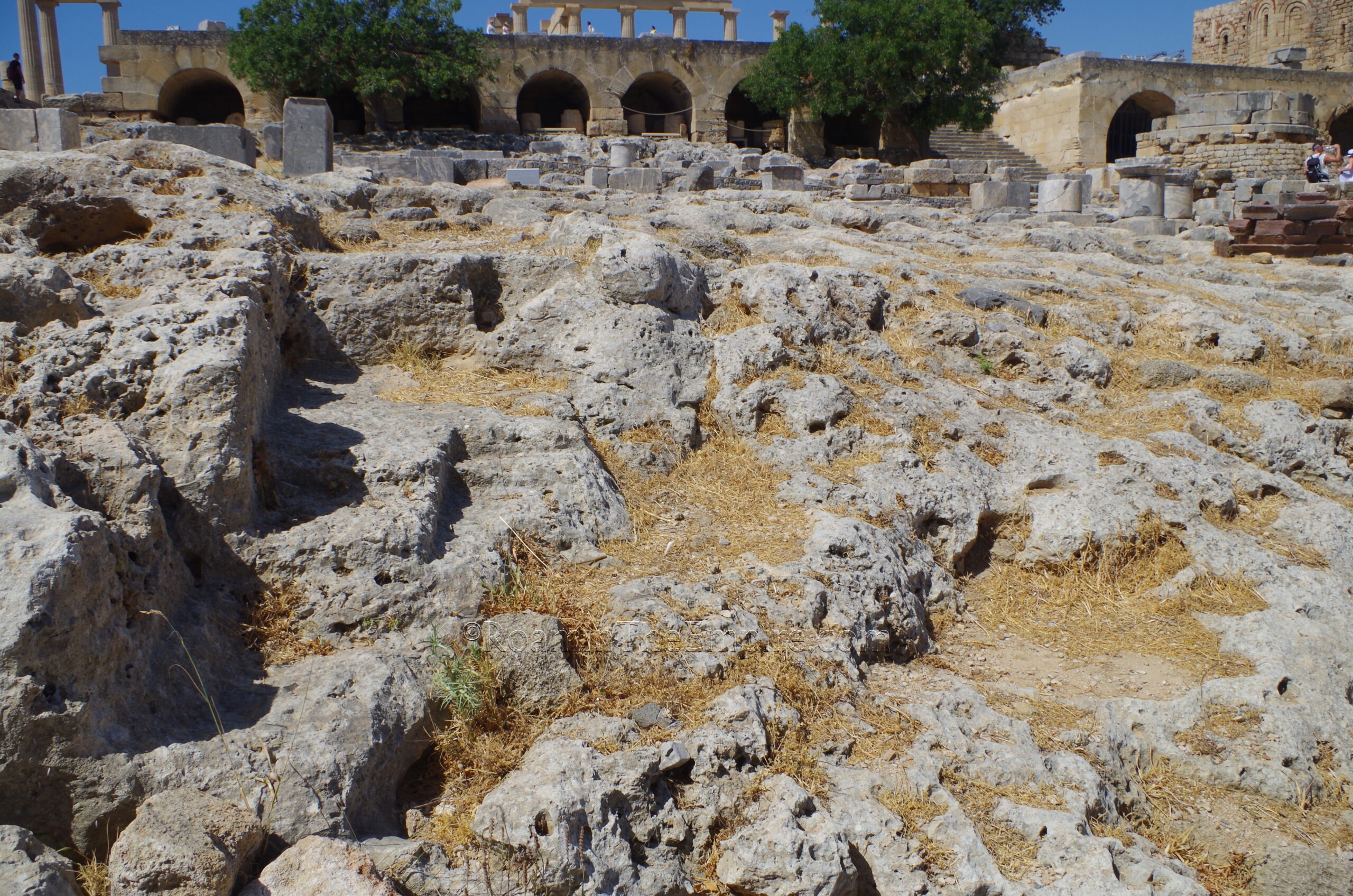
Also among this area are the very scant remains of a 3rd century CE Roman temple. Nothing of the actual masonry remains, as it was completely spoliated to construct the medieval fortifications, but the cuts in the rock of the acropolis that were made to accommodate the building materials are still visible. The temple seems to have been dedicated to the imperial cult of Diocletian. Northwest of the temple, some fragments of the 3rd century BCE fortifications of the acropolis can be seen on either side of the popular panorama spot that looks out over the inlet to the north. The first fortifications were built by Cleoboulos in the 6th century BCE, but nothing remains of that circuit of the walls. The walls and towers were repaired in the 2nd century CE, paid for by P. Aelius Hagetor, a priest of Athena Lindia, according to an inscription found on site.
Heading up the Hellenistic staircase between the vaults to the south leads to the lower terrace of the acropolis, which is bounded on the south and partially on the east and west by a stoa constructed in the late 3rd century BCE; earlier than the structures below, but later than those above it. The columns have been restored and reconstructed in two phases, the first occurring between 1936 and 1940, while the island was under the administration of Italy, as well as more recently. Hidden below the terrace are a series of five cisterns, of which shafts into these cisterns can be seen around the terrace, covered in metal grating.
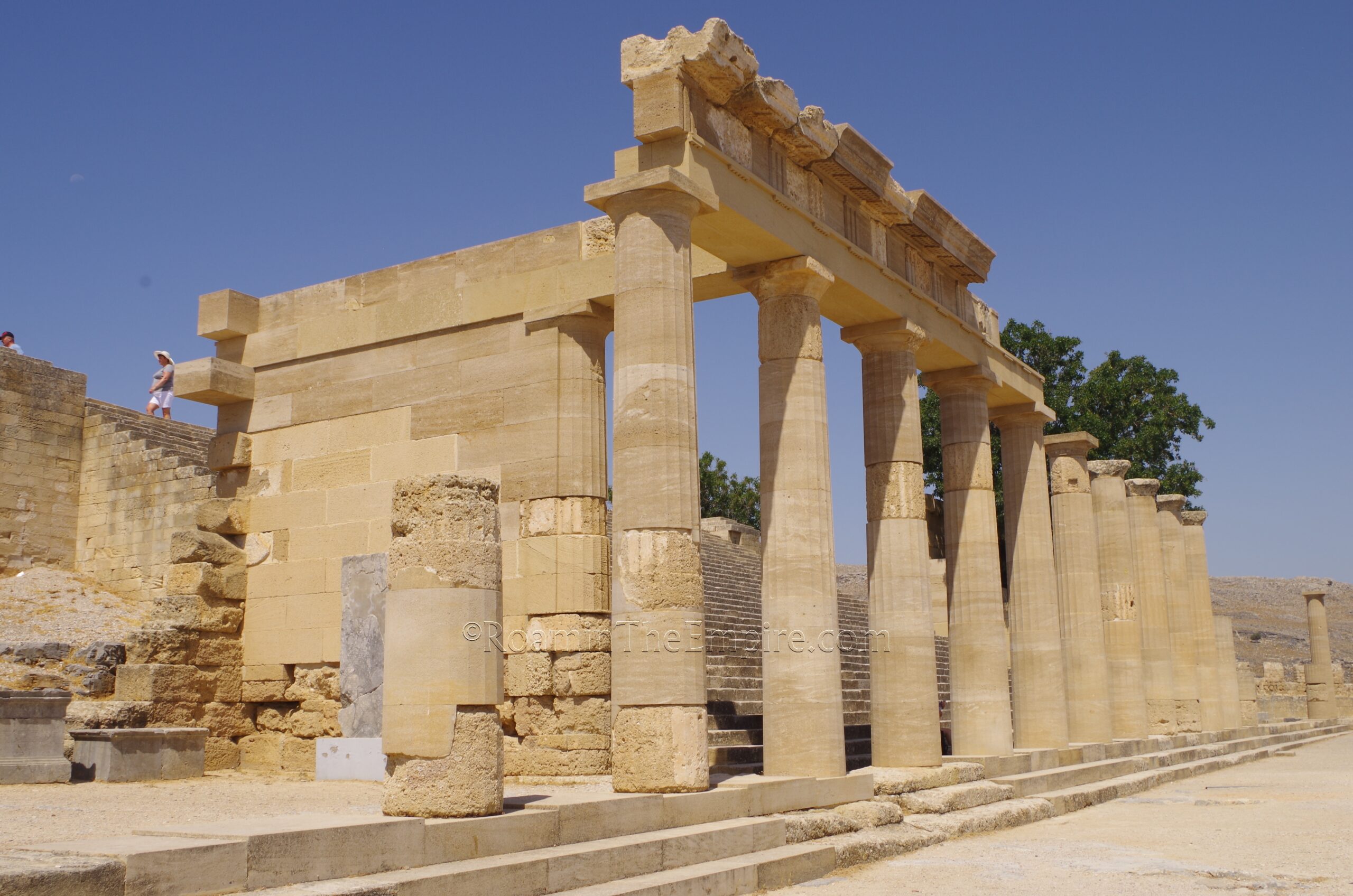
There are some interesting remains of monuments adorning the terrace on either side of the lower staircase, in front of the stoa. At the far eastern (southeastern) end are the remains of a votive statue of Nike on the prow of a ship (not unlike the previously mentioned Nike of Samothrace, though in much worse condition) dating to about 260 BCE. The votive was dedicated to Athena Lindia by sailors for a victorious naval engagement, including the trierarch Agathostratos, who is also known to have had a statue dedicated to him at Delos. Some fragments of another victory monument, a 2nd century BCE trophy dedicated to Athena Lindia for a victory in Asia Minor, can also be seen. A few fragmentary exedrae, statue bases and series of statue bases dedicated to priests of Athena Lindia as well as dedications to the gods are also displayed in these areas.
Continued in Lindus, Asiana – Part II
Sources:
Diogenes Laertius. Vitae Philosophorum, 1.6.
Finley, Moses Israel. Atlas of Classical Archaeology. New York: McGraw-Hill Book Company, 1977.
Grant, Michael. A Guide to the Ancient World: A Dictionary of Classical Place Names. New York: Barnes & Noble Books, 1997.
Higgins, Michael Dennis and Reynold Higgins. A Geological Companion to Greece and the Aegean. Ithica: Cornell University Press, 1996.
Herodotus. Historia, 1.144.
Homer. Illiad, 2.653-670, 5.627-668.
Pindar. Olympian 7, 65-75.
Pliny the Elder. Historiae Naturalis, 19.2.
Russell, Ben. Gazetteer of Stone Quarries in the Roman World. 2013.
Smith, William. Dictionary of Greek and Roman Geography. Walton & Murray, 1870.
Stillwell, Richard, William L. MacDonald, and Marian Holland. McAllister. The Princeton Encyclopedia of Classical Sites. Princeton, NJ: Princeton U Press, 1976.
Söğüt, İpek Sevda. A Synoptic Overview of the Lex Rhodia De Iactu. Presented at the 70th session of the Société Internationale Fernand de Visscher pour l’Histoire des Droits de l’Antiquité (SIHDA), September 2016, Paris, France.
Thucydides. Historia, 8.44.


